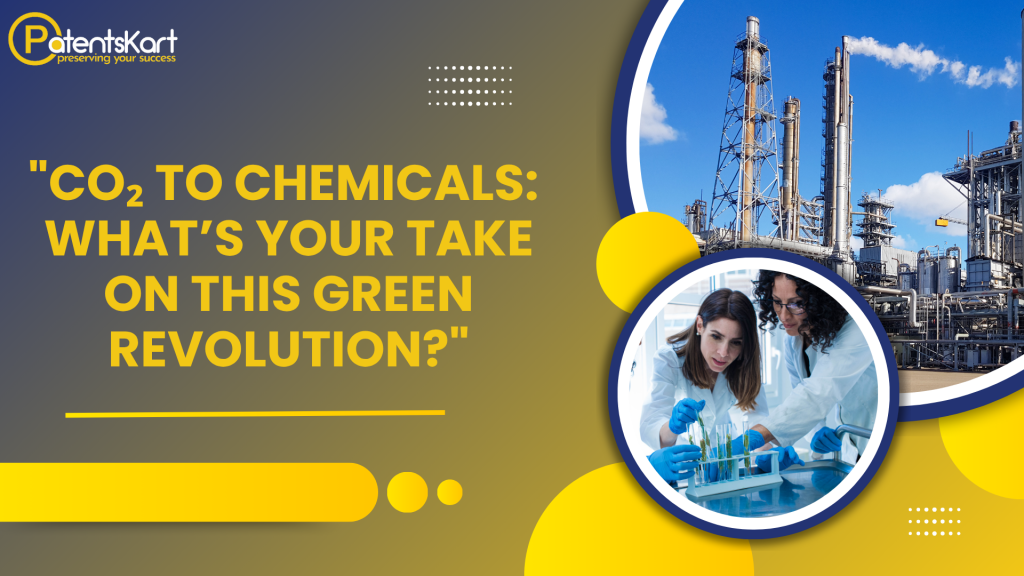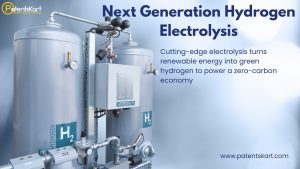What Is Carbon Utilization in Chemicals and Why Is It Crucial for the Future?
Carbon utilization in chemicals refers to the conversion of CO₂—typically a waste product—into valuable chemicals and fuels. This approach is central to a circular carbon economy and critical in reducing greenhouse gas emissions.
With rising climate concerns and stricter environmental regulations, industries are moving toward sustainable processes. Converting CO₂ into chemicals helps decarbonize manufacturing, reduce reliance on fossil fuels, and create a value chain from emissions.
How Does Carbon Utilization in Chemicals Work?
The process involves capturing CO₂ from industrial sources or the atmosphere and transforming it into value-added products using:
- Catalytic Conversion (electrochemical, photo/electro/photo-thermal)
- Biological Conversion (microbial, enzymatic)
- Thermochemical Pathways (gasification, reforming)
These technologies enable the production of fuels, polymers, methanol, ethanol, and other key building blocks.
What Are the Leading Applications of Carbon Utilization in Chemicals?
- Fuels & Energy Carriers
Captured CO₂ can be converted into valuable fuels such as methanol, ethanol, and other synthetic hydrocarbons. These serve as renewable alternatives to fossil fuels and can be used in transportation, power generation, and chemical feedstocks—significantly reducing carbon emissions while creating a circular carbon economy. - Industrial Chemicals
CO₂ is increasingly used as a raw material for producing industrial chemicals like urea (for fertilizers), syngas (a precursor to multiple chemicals), acetic acid, and formic acid. These applications not only utilize waste CO₂ but also offer a more sustainable alternative to traditional petrochemical processes. - Building Materials
In the construction sector, CO₂ is used to produce carbonated concrete, aggregates, and building blocks. This process not only traps carbon permanently in solid materials but also enhances the durability and performance of construction products, contributing to greener infrastructure. - Polymers & Plastics
CO₂-derived intermediates such as cyclic carbonates and polyols are used in the production of polymers and plastics. This allows manufacturers to reduce their reliance on fossil-based raw materials while creating sustainable, high-performance materials for packaging, textiles, and consumer goods. - Specialty Products
CO₂ is also being utilized in the creation of high-value specialty products, including fragrances, surfactants, and pharmaceutical ingredients. These niche applications demonstrate the versatility of CO₂ conversion technologies and their potential to serve premium markets with sustainable alternatives.
Who Are the Key Innovators in Carbon Utilization Technologies?
| Organization/Company | Contribution Area |
| Carbon Clean Solutions | CO₂ capture & conversion into methanol and fuels |
| Covestro | Polyols made from captured CO₂ for sustainable plastics |
| Twelve | Electrochemical CO₂ conversion into jet fuel and detergents |
| LanzaTech | Microbial gas fermentation of CO₂ into ethanol and chemicals |
| Air Company | Vodka, perfume, and sanitizer from CO₂-derived alcohols |
| Carbon Recycling Intl. | Emission-to-Liquid (ETL) methanol from CO₂ and hydrogen |
What Are the Major Technologies Behind CO₂ Conversion?
- Electrochemical
This method uses electricity, typically from renewable sources, along with specialized catalysts to convert CO₂ into valuable products like fuels and industrial chemicals. It’s highly scalable and allows for precise control over reaction conditions, making it ideal for on-demand, sustainable chemical manufacturing. - Photocatalytic
Leveraging sunlight and photoactive catalysts, photocatalytic processes drive the reduction of CO₂ into energy-rich compounds. This solar-driven approach mimics photosynthesis and offers a low-energy pathway for CO₂ utilization, making it an attractive option for long-term sustainable energy solutions. - Biocatalytic
In this method, enzymes or engineered microbes are used to convert CO₂ into useful biomass or biochemicals such as biofuels, organic acids, and proteins. It’s a nature-inspired solution that operates under mild conditions and supports carbon-neutral or even carbon-negative production. - Thermochemical
Thermochemical processes use high temperatures—often generated from renewable heat sources—to convert CO₂ through reactions like dry reforming, methanation, or gasification. These methods are suitable for large-scale, continuous operations and can integrate with existing industrial infrastructure. - Hybrid Processes
These systems combine multiple methods—such as electrochemical and biocatalytic—to maximize efficiency, selectivity, and scalability. Hybrid approaches can tailor the conversion process to specific outputs, optimize energy use, and enhance overall system performance for industrial deployment.
Which Universities and Research Centers Are Advancing This Field?
Academic institutions play a major role in R&D and patent generation:
- Stanford University – Low-energy electrochemical CO₂ conversion
- MIT – Catalysts for solar fuel generation
- University of Twente – Membrane technologies for CO₂ utilization
- Indian Institute of Science – Bioconversion and thermal processes
- University of Toronto – CO₂ to ethylene and ethanol using copper catalysts
How Is Carbon Utilization in Chemicals Benefiting the Environment?
- Reduces Greenhouse Gases: Utilizes waste CO₂ that would otherwise contribute to global warming
- Promotes Circular Economy: Creates marketable products from emissions
- Offsets Fossil Feedstocks: Replaces petroleum-based precursors
- Enhances Energy Efficiency: Integrates with renewable power sources like solar and wind
What Are the Key Industry Standards and Certifications?
| Standard or Guideline | Purpose |
| ISO 14064 | Greenhouse gas quantification and verification |
| ISO 50001 | Energy management systems |
| ASTM D6866 | Biobased content certification for CO₂-based products |
| Carbon Footprint Protocols | Emission tracking & lifecycle assessments |
What Is the Market Outlook for Carbon Utilization in Chemicals?
| Timeframe | Outlook & Developments |
| 2025–2030 | Commercial scale-up of CO₂-based fuels, plastics, and materials |
| 2030–2040 | Integration with national climate policies and carbon trading systems |
| Beyond 2040 | Net-negative emissions via CO₂ capture + utilization (CCU) + carbon sinks |
What Challenges Must Be Overcome?
Here’s a detailed bullet-point version of the key challenges in CO₂ conversion technologies:
- High Energy Demand
Many CO₂ conversion processes, especially electrochemical and thermochemical methods, require large amounts of energy to drive chemical reactions. Ensuring that this energy comes from renewable sources is essential to maintain the sustainability of the overall system. - Cost Competitiveness
CO₂-derived products must economically compete with conventional fossil-based alternatives. This includes the cost of feedstock, processing, and scaling. Without cost parity, widespread industrial adoption remains a significant barrier. - Technology Maturity
A large number of CO₂ conversion technologies are still in research or pilot stages. Challenges related to long-term stability, scalability, and integration with existing infrastructure limit immediate commercial deployment. - Policy & Incentives
The successful implementation of CO₂ conversion depends heavily on supportive policies, such as carbon pricing, subsidies, or tax credits. Regulatory frameworks that encourage innovation and adoption are crucial for accelerating market growth.
How Can PatentsKart Help You Lead in Carbon Utilization Innovation?
PatentsKart offers tailored IP services that empower organizations to innovate responsibly and strategically:
- Patent Landscaping – Spot trends and white spaces in carbon utilization
- Competitive Intelligence – Analyze global innovators and R&D direction
- Patent Drafting & Filing – Protect your carbon utilization technologies
- FTO & Risk Analysis – Navigate safely in a dense patent ecosystem
Let us help you bring your sustainable vision to market.
FAQs on Carbon Utilization in Chemicals
-
What is carbon utilization in chemicals?
It’s the conversion of captured CO₂ into usable chemical products like fuels, plastics, and industrial materials.
-
How is carbon utilization different from carbon capture and storage (CCS)?
Unlike CCS, which stores CO₂ underground, carbon utilization turns CO₂ into valuable products.
-
Can carbon utilization be profitable?
Yes. With scaling and government incentives, many CO₂-based products are becoming commercially viable.
-
Is CO₂ utilization scalable?
Yes, but scalability depends on energy input, technological maturity, and integration with renewables.
-
What sectors benefit most from carbon utilization?
Energy, manufacturing, agriculture, construction, and consumer goods all benefit from CO₂-derived products.
Recent Blogs by PatentsKart
- How AI in Telemedicine Is Reshaping Remote Care
- Heated Tobacco Products vs E-Cigarettes: A Patent Analysis
- Biometric Blockchain Wallets: The Future of Secure Web3 Access
Conclusion: Is Carbon Utilization the Future of Sustainable Chemistry?
Absolutely. Carbon utilization in chemicals presents a viable path to fight climate change while adding economic value. It fosters innovation at the intersection of green energy, advanced materials, and industrial transformation. As global demand for sustainability intensifies, businesses and governments alike are investing in this frontier.
With expert support from PatentsKart, your carbon utilization breakthroughs can not only help save the planet—but also lead the market.
Ready to protect your carbon utilization innovations? Contact PatentsKart today.







